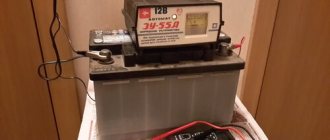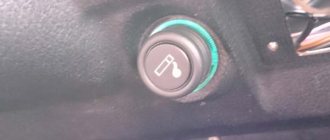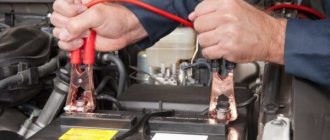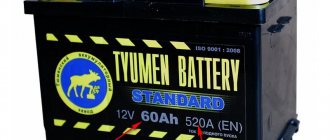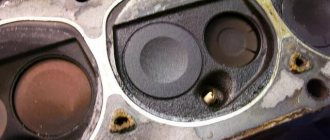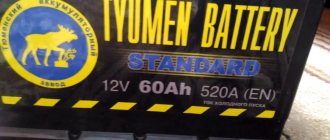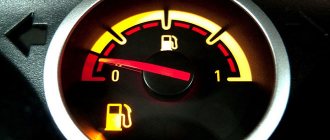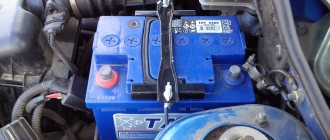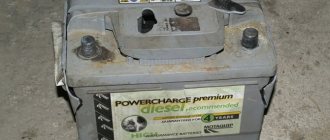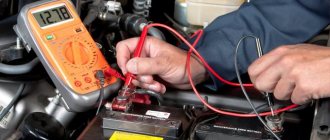Car battery
A car battery is an integral part of technology. Without it, no car will work. Many motorists do not attach much importance to the battery design. It is enough for them to carry out schematic maintenance, in which everything is familiar and understandable.
They connect the wires to the terminals, then to the battery terminals. But there are times when a new car charger is purchased, and the polarities on it are reversed. That is, on the old element there was a “plus” on one side and a “minus” on the other, but now it’s the other way around.
The main problem appears when connecting the battery: the wires do not reach the corresponding terminals. For such cases, knowledge about battery polarity is needed.
How to determine: direct or reverse polarity before the eyes? After all, this is a huge difference that affects the functionality of the battery. And, therefore, cars. Let's try to figure out how direct polarity differs from reverse polarity in a car battery. What is this polarity? There are current carrying elements on the body of each battery. These are the pins to which the on-board network will be connected.
Find out the charging time of your battery
Polarity selection
What happens if you reverse the polarity?
Many inexperienced drivers, after removing the battery for recharging, install it incorrectly, on the contrary, confusing plus with minus. If the wires are connected incorrectly, strong sparking occurs in the contacts, and any elements of the car's electrical circuit can burn out. But modern machines provide protection, and first of all, in the event of a short circuit, the fuses are knocked out.
If the driver suddenly reverses the polarity of the battery, the following may happen:
- the instruments on the panel will no longer be displayed, the instrument lights will go out;
- the diode bridge or voltage relay in the generator will burn out;
- the engine control unit fails;
- The high power fuse will blow.
More often, something goes wrong in the electrics of Japanese cars - Asian equipment is not designed for incorrect connections.
You need to be able to mix up the battery connection, because with this connection:
- The length of the positive wire is not enough, it has to be pulled tightly;
- The positive terminal is thick and the ground wire is not fixed to it.
Usually, when the polarity is reversed, a short circuit occurs - it is unlikely that the car owner will be able to securely fasten the wires to the terminals. The sparking at the moment of contact is very strong, and in this case the terminals do not fit in size.
Location of current carrying elements
Most often you can find two combinations of terminal locations. This is the polarity, which can be:
- Direct, when the positive terminal is on the left and the negative terminal on the right. Sometimes this distribution of current outputs is indicated by one, which can often be seen on batteries from domestic manufacturers. Finding the markings is quite simple; just turn the battery face down so that the current carrying elements are located at the bottom. If the plus is on the left, then it is straight polarity. Such batteries are installed on Russian cars. A striking example is Priora.
- Reverse, when the positive terminal is located on the right and the negative terminal on the left. Often this type of polarity is designated zero, which is considered a purely European development. The process of finding information about the location of the poles is the same. If the minus is on the left side of the label, this indicates reverse polarity of the battery. Most often, such batteries are found in foreign cars.
How to distinguish batteries
Often in the conversations of car enthusiasts the phrase about the mythical Asian and American polarity pops up. In fact, these are rumors: such things do not exist in nature. Most likely, the concept of location of current leads is confused with battery sizes. Asian-type batteries are distinguished by more compact sizes, the absence of a protrusion on the top cover of the device, and thin terminals. American batteries also have characteristic features - the location of current-carrying parts on the top panel. We recommend: Types and features of choosing batteries for a car As for the polarity of the battery, Russian and European can be easily distinguished by the location of the terminals or markings (0 and 1). Otherwise, the layout, box dimensions, number of cans and other external features are identical, so even an experienced motorist can get into trouble without looking at the label. In order not to guess, it’s easier to contact the seller, who will select a battery that matches a particular car brand.
Batteries for trucks
The terminal arrangement system on batteries for trucks is not much different from cars. Both terminals are on one of the short sides of the box. Determining the polarity of the battery is simple; you need to look at the location of the terminals:
- If the current terminal marked “+” is on the left side, then this is reverse (European) polarity, which can also be marked with a three.
- If the positive current-carrying element is placed on the right, then this is direct (Russian) polarity. Some manufacturers may designate it as a four.
Frequently, batteries for trucks are found with a layout that is marked with the number 2. In this case, the terminals are located diagonally on the top panel.
Trucks can be equipped with one of two types of batteries, but the terminals are usually located on one of the short sides. In this case, you can also determine whether the polarity of the battery is direct or reverse visually:
You need to turn the battery so that it faces the viewer with the side on which the terminals are located and pay attention to which of the current leads will be on the left and which on the right. If the “plus” is on the left, then this is reverse polarity, which in the case of trucks is often called European. The number “3” was chosen to designate it. If there is “minus” on the left and “plus” on the right, this is straight polarity, which can also be called Russian
Such batteries are marked with the number “4”.
We recommend: How many amperes are there in a car battery?
So, the two polarities of batteries for passenger cars are designated by the numbers “0” and “1”. To designate batteries designed for installation in trucks, the numbers “3” and “4” are used.
Uncommon battery types
There are batteries that are designated by the number “2”, but they are not used so often. The arrangement of the current leads on them can be called diagonal: in one corner on the top cover there is a terminal with a minus sign, and in the opposite corner there is a terminal with a plus sign. In this case, the surface of the cover can be compared to a boxing ring, and the terminals themselves can be compared to boxers at the beginning of a round.
It is also worth mentioning two less common types, which are marked with the numbers “6” and “9”. If a six is indicated, it means that the terminals are located on the cover in two corners, but not in opposite, but in adjacent ones. If a nine is indicated, then the “plus” and “minus” are opposite each other.
Tags: machine, ampere, beat, sconce, view, choice, generator, engine, house, , capacity, replacement, charging, sign, like, computer, , marking, power, multimeter, load, connection, polarity, rule, principle , wire, start, , work, size, relay, repair, row, garden, light, network, twist, connection, means, circuit, ten, type, current, trigger, , shield, electronic
What are the consequences for a car owner when the polarity is reversed?
It is important to remember: the design of the car assumes the use of only batteries of a certain size and terminal location. It is possible to install a battery of similar capacity, but not the correct polarity, into the seat. But it will no longer be possible to connect it in standard mode. Because the wires simply won't reach.
It is no coincidence that such a difference between batteries is present: incorrect polarity will cause damage to the car’s electronics. The engine control unit may fail and a short circuit may occur. It is important to remember: not all electrical appliances fail when changing poles. But many will be damaged. Such situations should be avoided.
Moreover, in some cases, the holes in the terminals are even different. Usually the diameter of the positive one is slightly larger than the negative one. Therefore, it will be difficult to confuse them even by accident. Moreover, changing the poles can cause the starter to rotate in the other direction. Some engines may require major overhaul after this.
Recommended: How does a manual transmission work?
What are the consequences if the terminals are mixed up?
The consequences may be different, depending on the situation in which the terminals were mixed up.
When installed on a vehicle
In the event that the plus “+” with the minus “-” on the battery were mixed up at the time when the battery was installed on a car with a running engine, then the owner of the vehicle will receive a fairly large number of troubles, ranging from the fact that it may fail generator diode bridge, as well as other electronic devices in the car.
Most often, this situation happens with old vehicles, where there was no protection against incorrect battery connection.
Important! A battery that has been connected incorrectly and left in the vehicle for a long time can cause a short circuit and fire.
In the event that the terminals are mixed up and the car does not start at this moment, then the owner will face much less problems.
In such a situation, only devices that were turned on earlier, for example, a radio, clock, etc., can fail. Sometimes, the situation is saved by blown fuses that are installed in the power circuit, naturally, if they meet the requirements of the maximum current in the circuit.
Consequences of incorrect connection
Many inexperienced car owners wonder whether it is possible to install batteries with a different polarity in the car and what the consequences of an incorrect connection may be. Mixed terminals can lead to serious consequences.
Serious damage that can result from choosing a car battery with the wrong polarity includes:
- A short circuit that ends with several fuses blowing. This kind of damage can be fixed quickly and inexpensively. You can prevent burnout if you promptly notice the sparks that appear when connecting the battery.
- Ignition that occurs when an incorrectly connected battery is used for a long time. Because of this, small wires light up first, and then larger elements.
- Destruction of the battery, which occurs due to the melting of some parts and discharge of the battery due to the effects of reverse charge.
- A breakdown of the on-board computer, the repair of which will be expensive for any driver due to the high cost of a new board.
- Burning fuses, which can be replaced with new protective elements within a few minutes.
- A generator breakdown, the replacement of which can hit the pocket of an inattentive motorist. Often, protective fuses are installed on it to prevent such breakdowns. In this case, you will not have to change the generator; it will be enough to buy a new diode bridge.
- Damage to electrical wires and alarms, which quickly fail if the battery is installed incorrectly.
In any case, it is better to change the battery with the wrong polarity. The discrepancy between the model will help determine the length of the negative and positive wires, which simply will not be enough for connection. Of course, you can cheat and lengthen them, but an incorrectly selected cross-section or weak braid will lead to the same consequences as an incorrectly selected battery.
We recommend: Search and selection of batteries by car make and model
Is it possible to change the polarity on a car battery?
Nowadays, most manufacturers strive to eliminate the possibility of incorrect connection. For this purpose, the negative and positive terminals are made of different sizes. The wires from the on-board network have a certain length and can only be attached to the required sides. But car owners have the opportunity to bypass the protection by connecting the contact through an adapter.
Battery adapter
As a result, the plus becomes on the wrong side, a polarity reversal occurs, which is dangerous for all car systems. Of course, some car owners specifically reverse the polarity of the old battery in order to extend its life. But this operation must be performed at your own peril and risk, and the consequences are often unpleasant. Polarity reversal is only possible under the following circumstances:
- The banks are in good working order and do not short out.
- Inside the battery, normal electrolyte density is maintained.
- The plates are quite thick and have no damage.
If you urgently need to replace the battery, you can install the device with inappropriate polarity. In this situation, the battery must be installed so that the wire with a positive charge reaches the terminal. The negative one is mass; it is attached to the body, so it can be extended. To do this, the old wire is disconnected, and a new one with a larger cross-section is fixed in its place. Unfortunately, the positive one cannot be unscrewed and cannot be replaced or extended.
Ways to determine polarity
You can determine this parameter for correct connection of wires by carefully inspecting the device. As mentioned above, each polarity has its own marking, as well as symbols near the terminals for connecting wires. The service book for the car, as well as the tips given above (the author of the video is the Nik86 auto-construction channel), will allow you to find out this parameter more accurately.
We recommend: Car rental in Moscow: prices, conditions and advice from professionals
If there are no marks or signs of polarity on the battery design, and accordingly, you do not know how to connect the wires, then you can try to conduct a test. You will need a multimeter, the probes of which must be connected to the terminals. If the voltage on the tester display is positive, this indicates that the probes were connected correctly (there are o and “-” on the probes themselves). If the diagnostics showed a negative voltage, then you connected the testing device incorrectly.
There are several other ways to determine:
- By color designation. Many modern batteries have color markings - in this case, the positive terminal is always marked in red. So it’s impossible to confuse the conclusions.
- By pin sizes. Experienced car enthusiasts know that the positive terminal is always larger than the negative terminal. This difference is typical for many modern batteries, and even as the device wears out, it remains. As you understand, using these methods to determine a parameter is much easier than using a multimeter.
Batteries manufactured in the USA simply do not have pins - instead, the device is equipped with recesses into which conductive contacts are mounted.
Determination of polarity by alternative methods
If it happens that you don’t have a multimeter at hand, but you need to find the polarity, you can use alternative and “folk” means.
For example, speaker wiring charges are checked using a 3-volt battery. To do this, you need to briefly touch the wires connected to the battery to the speaker terminals. If the cone in the speaker begins to move outward, this will mean that the positive terminal of the speaker is connected to the positive terminal of the battery, and the negative terminal to the negative terminal. If the diffuser moves inward, the polarity is reversed: the positive terminal is connected to the minus, and the negative terminal to the plus.
If you need to connect a DC power supply or battery, but there are no polarity markings on them, and you don’t have a multimeter at hand, plus and minus can be determined by “folk” methods using improvised materials.
The easiest way to determine polarity that you can use at home is to use potatoes. To do this, you need to take one raw potato tuber and cut it in half. After this, two wires (preferably of different colors or with any other distinctive sign) with their bare ends are stuck into a cut of potato at a distance of 1-2 centimeters from each other.
The other ends of the wires are connected to the constant current source being tested, and the device is turned on (if it is a battery, then after connecting the wires, nothing else needs to be done) for 15-20 minutes. After this time, a light green spot will form on the potato cut around one of the wires, which will be a sign of a positive charge on the wire.
The second method also does not require any special devices or tools. To determine the polarity of the wires of a DC source, you will need a container of warm water into which two wires connected to the power source are lowered. After connecting the device to the network, gas bubbles (hydrogen) will begin to appear around one of the wires - this is the process of electrolysis of water. These bubbles form around a source of negative charge.
The following method is suitable if you have an unused, working computer cooler. The method for determining polarity using this method is that the cooler must be powered from the uninterruptible power supply being tested. But often there are three wires in coolers:
- black, responsible for negative charge;
- red, responsible for positive charge;
- yellow is the speed sensor.
In this case, the yellow wire is ignored and is not connected anywhere. If, after connecting the cooler to a constant voltage source, the cooler starts to work, then the polarity is determined correctly, the plus is connected to the red wire, and the minus is connected to the black. And if the cooler does not work, this will mean that the polarity is incorrect.
To do this, you need to touch the indicator to one of the battery terminals, press your finger to the back of the indicator (to the contact on the handle), and touch the second terminal of the battery with your hand.
If the indicator starts to light, then the charge of the tested terminal with which it is in contact has a positive value, and if the indicator does not light up, the terminal is negative. But this method of determining polarity has one drawback. If the battery is discharged or damaged (broken), the indicator will light up when in contact with both terminals, making it impossible to determine the battery poles.
How to buy the right battery
When buying a battery in a store or at a car market, the car owner needs to select it according to the main parameters:
- sizes;
- polarity;
- containers;
- starting current.
If the battery is too large, it will not be possible to fix it on the battery platform, and you need to be aware that the plates of an unsecured battery will quickly fall off due to vibration. The polarity of the new battery must correspond to the type of car, and if the driver is not at all versed in cars, he must at least remember how the terminals of the old battery are located, or sketch, so as not to forget, the location of the terminal pins. It is also important to choose the same polarity as it was, so as not to get confused - if the battery is connected incorrectly, a short circuit occurs with unpleasant consequences for the car owner.
You should not buy a battery with a reduced capacity; for a standard passenger car without air conditioning and other additional electrical equipment, the battery must have a capacity of at least 55 Ampere-hours. If there are many consumers in the electrical circuit, you can purchase a 60 Ah battery.
When purchasing a new battery, you should try to purchase a battery with the maximum starting current. There will be no harm to the engine from such a battery, but the starter will be able to crank the engine in frosty weather without problems. It would also be a good idea to take a voltmeter (multimeter) with you and check the voltage at the battery terminals - for a normally charged battery it should be about 12.5 Volts.
We recommend: Classification of passenger car bodies
Determination of magnitude
To understand what polarity the battery has (straight or reverse), you need to place it in front of you, facing the front side of the device, on which there are plus and minus signs. If the minus is on the left and the plus is on the right, this is nothing more than the opposite. If, on the contrary, there is a minus on the right and a plus on the left, this is a straight line.
To be able to accurately determine the type of polarity at a glance, it is enough to pay attention to one of the two opposite signs. https://www.youtube.com/embed/8NDkZECcNvM
When marking batteries, special numbers are used. For example:
- Straight polarity of the battery is marked with the number “1”. Such batteries are installed in domestically produced cars. Today the Lada Priora is equipped with them.
- Reverse battery polarity. Marked with the number “0”. It is usually present in batteries of foreign-made cars. Of course, this arrangement also occurs on our cars, but it happens very rarely.
Apart from the location of the terminals, there are no significant differences between the batteries. However, the location of the “plus” and “minus” itself is not such a significant difference. They have the same appearance: the bodies are identical, the number of cans is the same. The strength of the current they generate is also the same, and even the labels on them are practically the same.
You can easily make a mistake when purchasing and purchase the wrong battery that you need: for example, buy a battery with direct polarity when reverse polarity is required.
It’s good if the buyer is able to determine this indicator himself: then he will just need to look at the product and choose the one he needs. If a car enthusiast who comes to the store is not aware of what it is and how it is determined, he should turn to the seller for help, who will definitely tell him. To do this, just tell him your model.
Direct and reverse polarity
There is no difference between batteries with the same characteristics, but completely different. But placing the terminals in different places creates certain installation problems. There is an established list of symbols that allows you to determine polarity. This characteristic can also be determined visually. Order:
- it is necessary to place the battery with the side with the terminals closer to you, on a horizontal surface;
- location:
- straight polarity - positive terminal on the left;
- reverse polarity - positive terminal on the right.
All vehicles are designed for a specific terminal arrangement. Direct polarity is usually used on cars produced at the AvtoVAZ plant, as well as cars of Asian origin. For example, Kia, Daewoo, Hyundai and others. Direct polarity was developed in the Soviet years by domestic designers.
That is why many sellers in stores call this polarity Russian. The straight line is also designated by the number “1”. Accordingly, the location of the terminals on different types of batteries is exactly opposite. The reverse is usually used on foreign-made cars. As a rule, these are Ford cars, most other Americans. Also, most manufacturers in Europe use this type of polarity.
In addition to those indicated above, some cars offer an alternative arrangement of polarities. “American” - assumes that the terminals for connecting to the vehicle are located not on the top, but on the side.
Differences between positive and negative terminals
First, it is advisable to understand the structure of the battery, the most common type of which is lead-acid. It is a plastic box divided into 6 sections, each of which is a separate battery. Each section contains a package of plates with alternating polarity. Lead dioxide is applied to the plates with a positive charge. Sponge lead is used for those having a negative charge.
The terminals can be distinguished by their appearance; European ones are cylindrical in shape, that is, they have a round cross-section. Asian ones are divided into two varieties; they can be round or flat. If flat ones are used instead of round ones, they are often threaded. The difference in size is also observed: in European ones the minus diameter is 17.9 mm, and in Asian ones it is 11.1. The positive contact in European cars has a diameter of 19.5 mm, in Asian cars - 12.7.
If a battery with a different polarity is installed, the contacts are not connected due to the difference in diameter. Connection is only possible through a special adapter. Another difference between the two types is that in European-type batteries, the terminals are hidden in niches, so they do not stand out on the body. In Asian ones, they rise above the lid and, when installed on another car, can even rest against the hood. The main differences between terminals with different charges are shown in the table:
| Main Differences Between Positive and Negative Terminals | ||
| Plus | Minus | |
| Location | Direct polarity or “Asia” is the terminal on the left, reverse polarity or “Europe” is on the right. | Forward polarity is the terminal on the right, reverse polarity is on the left. |
| Size | "Asia" - 17.5 mm, "Europe" - 19.5 mm. | "Asia" - 11.1 mm, "Europe" - 17.9 mm. |
| Color of cap or identification ring | Red | Blue, grey, black or silver. |
| Form | They have the same shape - cylindrical; in Asian batteries they can be flat. | |
| Height | They do not differ in height; in “Europe” type batteries they are located in niches on the lid, in “Asia” type batteries they rise above the lid. | |
What does direct and reverse mean?
Let's take a closer look at each type of battery:
- With straight polarity. This development is relevant mainly for domestic engineers. Its peculiarity is that the positive terminal “+” is located on the left side, and the negative terminal “-” is located on the right side of the top cover of the case.
- With reverse polarity. Such batteries are mainly used in European countries. The polarity is located as follows: minus “-” is on the left, and plus “+” is on the right.
To be fair, it is worth noting that not all cars from Europe have batteries with reverse polarity; often those models that are assembled in the CIS countries are equipped with direct polarity.
Many motorists carry out battery maintenance on their own, and one of the few problems that arise is determining the polarity. You can usually find out where the negative and positive terminals are by visual inspection. If that's not enough, no expensive tools or equipment will be required. You cannot operate the car unless you are completely sure that the battery is connected correctly. When it is impossible to carry out the check yourself, it is worth contacting specialists.
scitalec › Blog › I haven’t changed the battery for a long time
I haven’t changed the battery or charged it for more than ten years. Therefore, something was erased from memory, and somewhere I fell behind life in this matter. I read and took note of the information, which I also want to share with you. Maybe it will be useful to you, probably more than one of my batteries has survived such frosts.
Battery polarity is forward and reverse. What is it and what is the difference between them?
avto-blogger.ru/akb-avto/…pryamaya-i-obratnaya.html
Domestic cars have direct battery polarity, but many foreign cars have reverse polarity (not all). Novice motorists do not know what polarity is and how they differ.
Polarity is the location of external current-carrying elements (current leads) on the front or top cover of the battery. The most common layouts are the so-called “direct” and “reverse”, but in fairness it should be noted that there are also very exotic arrangements of current leads, but as a rule they have not taken root in our country or in foreign countries. Simple in other words, this is the location of the terminals - in some cases the positive one is on the right, and in another case on the left. This is where the main difference lies.
Straight battery polarity
Direct (sometimes marked as “1”), this is a purely domestic development. It’s easy and simple to identify - take the battery, turn it towards you (facing it) so that the current leads are at the bottom (the label is in front of your eyes). If the positive terminal is on the left and the negative terminal on the right, this is straight polarity. Here is a diagram. Such batteries are found on many domestic cars, for example on our VAZs, in particular on the Priora.
Reverse battery polarity
Reverse - marked as “0”, European development. It differs from the direct one by connecting the battery “cans”. Determine - turn the battery “face”, the current terminals are at the bottom, the label is in front of your eyes. If the negative terminal is on the left and the positive terminal on the right, this is reverse polarity. Let's look at the diagram.
Such batteries are found on many European cars, there are exceptions, but rarely.
How do batteries differ? There are minimal differences, except for the pole. I would like to note that externally the batteries are almost identical - that is, the body, the number of cans, the current strength, and even the label. And it is very easy to confuse the battery, that is, you can buy it with the wrong location of the current leads (terminals). Even an experienced driver can get into trouble if he makes a spontaneous choice. Therefore, if you don’t understand this yourself, ask the seller to choose one for your car, as a rule, they have catalogs that describe suitable models
This will be best! Therefore, if you are thinking about replacing the battery, you need to know exactly and determine the location of the terminals, this is extremely important!
Is it possible to install a different polarity? I often get asked this question; it happens that beginners buy out of inexperience, and often even install and mercilessly “burn” their cars! Guys, if you mix up the terminals, then at the very least your electronics may burn out along with the ECU, and at the most, you’re not far from a fire
Therefore, compare at least with the old battery, don’t be lazy, you need to know exactly how your poles are located. If you determine that you chose the wrong one, then you need to definitely change the new battery to the correct one! This is very important! However, the following questions often arise: “I recognized it only after installation, the terminals were torn and even shorted a little, the store does not replace it under warranty. What to do? how to install?” The whole point is that you simply won’t have enough negative (positive) wire! You either need to build it up, starting wires may come in handy, but all this is just hack work! You may have calculated the wire cross-section incorrectly
